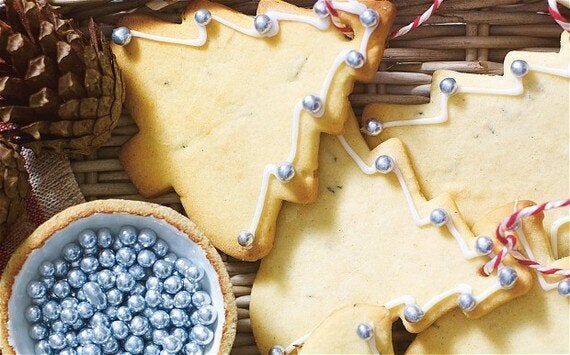I like using Douglas Fir to flavour my Christmas biscuits and minced pies. It isn't a true fir, hence its Latin name Pseudotsuga. A native of the USA, one of the oldest U.K. Doulgas Firs is in Scone Palace, in Perthshire Scotland. It was brought to the UK, in seed form from North America in 1826 by David Douglas, who was born in the village of Scone. The cones are smaller than other pines and have interesting distinctive 'tongues' that protrude between the cone scales. If you can't forage pine needles, fresh rosemary will also work in this Christmas cookie recipe.

A delicious recipe for pine flavoured Christmas Biscuits
(from The Forager's Kitchen by Fiona Bird)
125g sifted icing sugar
200g butter, cut into small cubes
1 small egg yolk
300g plain flour, plus extra for rolling
Glacé icing and silver balls, to decorate (optional)
Method
Preheat the oven to 375°F/190°C/gas 5.
Put the dry Douglas fir needles and any seeds with the icing sugar in a food processor. Cover with a tea towel (the dust seems to escape even when the lid is firmly on), and blend to chop the pine needles finely.
Add the butter and egg yolk to the food processor, and then enough flour to make dough. Wrap in cling film, and refrigerate for at least an hour before using.
Lightly dust a work surface with flour, and roll out the pine dough. Stamp out thin 3mm Christmas trees with a biscuit cutter, place on a non-stick baking tray, and bake for approximately 8-10 minutes (depending on thickness).
Check after 8 minutes -- the trees will brown very suddenly. Cool for 2-3 minutes, then use a spatula to transfer the trees to a wire rack.
To hang the cookies on a Christmas tree: use a skewer to make a small hole in the dough of the Christmas tree (to thread ribbon through) before baking. Decorate with glacé icing and silver balls if desired, or frame the trees with a small amount of icing, thereby accentuating the natural speckles of the pine needles in the dough.
Douglas Fir Syrup
Splash into vodka or gin cocktails, or simply dilute with tonic water.
Makes about 400ml
25g Douglas fir, Scots pine, or other edible pine needles, rinsed in a sieve and patted dry
200ml boiling water
400g caster sugar
Method
Put the pine needles in a large sterilised jam jar (with a lid) and pour in the boiling water. Cover and leave for 24 hours.
Strain the pine-needle-infused water into a jug.
Put the sugar in a clean saucepan and add the strained water. Heat over a low heat to dissolve the sugar. Do not stir.
Bring to a boil for 2-3 minutes until you have reached the desired consistency.
Leave to cool and then pour into a sterilised bottle and refrigerate. Use within a month.
Wild Notes
For greener syrup, add a tablespoon of washed and dried chickweed tops, after removing the boiled syrup from the heat.
Blend in a food processor and strain again before bottling. As with all cordials and syrups, use refined sugar.